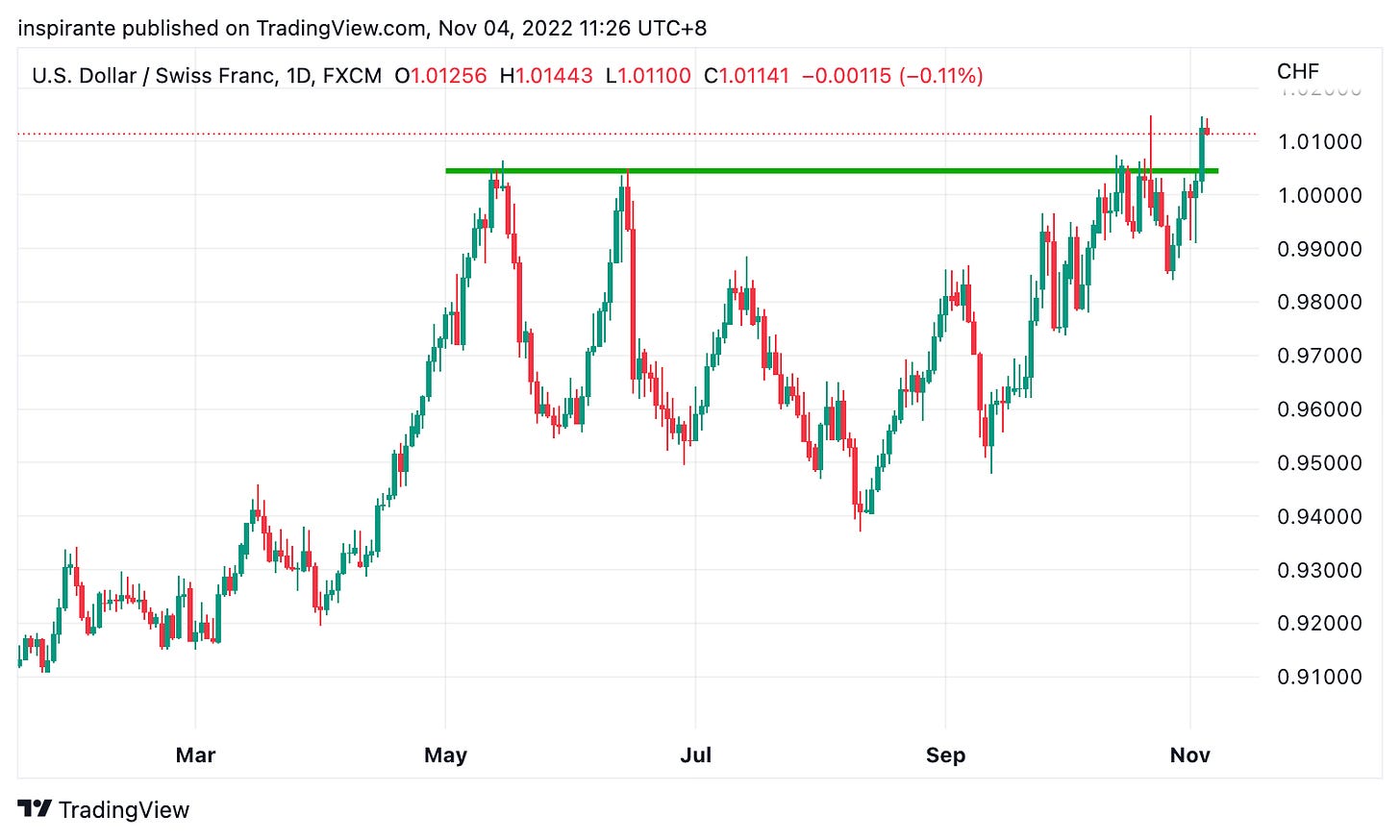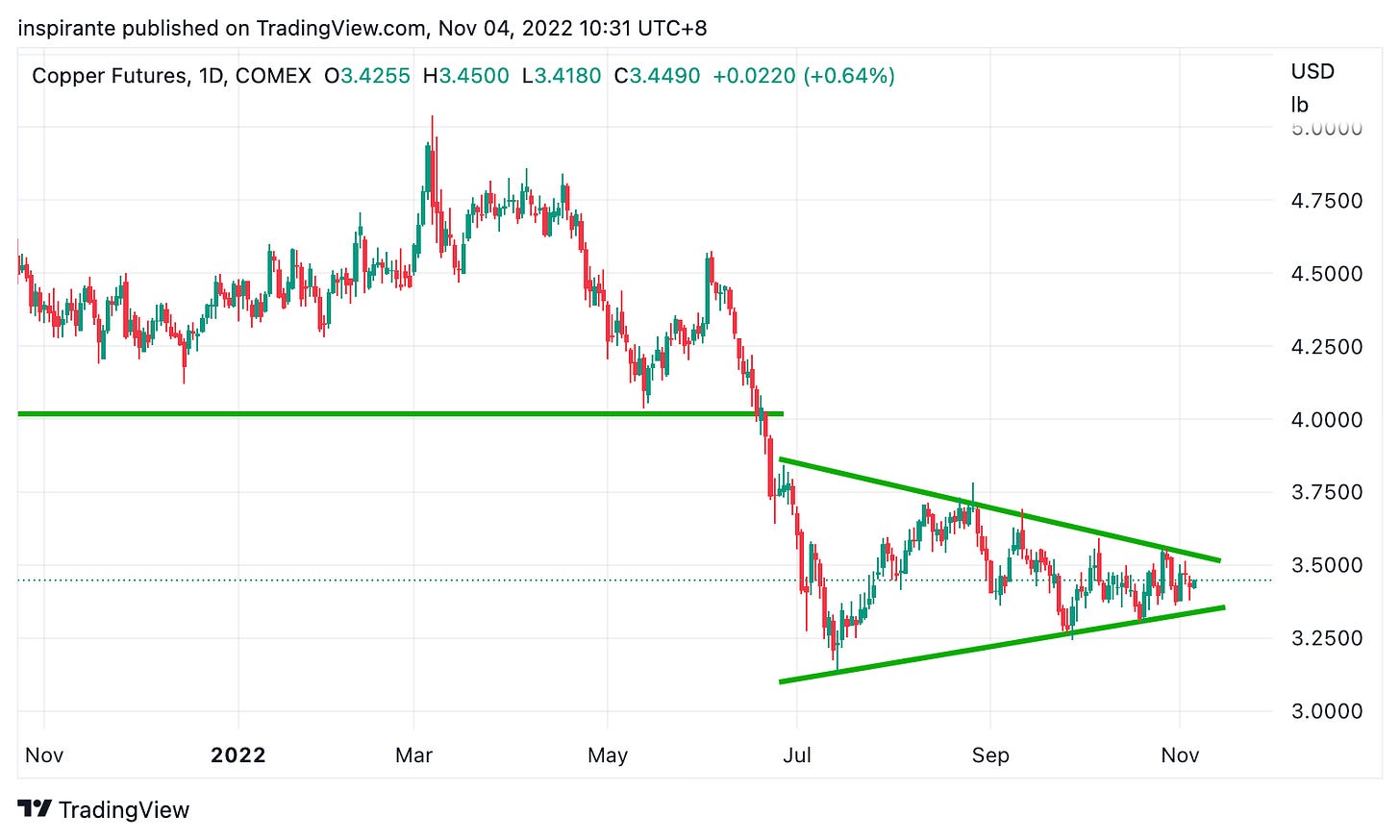Markets in Focus
The strong uptrend for the US Dollar remains very much intact after a brief correction in late October. It has formed a bull flag, which often suggests that the prior trend will continue after a period of consolidation. Until the green trendline is decisively broken, it is still premature to call the top of the greenback.
The significant resistance level slightly above 1.00 was broken for USD/CHF. The bulls seem to have the upper hand, finally. Once such heavily battled levels are breached, the market usually needs to find the next resistance where equilibrium is restored at a much higher level.
Copper has been consolidating in a symmetrical triangle since the selloff in June. It is currently near the apex, where breakout tends to happen on either side of the triangle. We are watching the price action of copper closely.
We noted the potential strong support level for heating oil at around 3.0 in late September. It has rebounded sharply since then and arguably has completed a five-month bull flag. A bull flag breakout generally suggests a resumption of the prior trend.
RBOB gasoline has completed and broken out from a three-month inverted Head-and-Shoulder (H&S) bottom. Both gasoline and heating oil price actions suggest the current bull run in energy has not ended yet.
Market Views
The November FOMC meeting has put the market on a rollercoaster ride. The market interpreted the initial policy statement as dovish because the committee seemed to have suggested a slower pace of tightening in December. Risk assets went through a short-lived rally. The U-turn came abruptly when Chairman Powell said, “It is very premature, in my view, to think about or be talking about pausing our rate hikes.” He also added that “the ultimate level of interest rates will be higher than previously expected.” There went the “Fed Pivot” many investors were hoping for.
After four consecutive 75bps rate hikes, which in and of itself is already historic, the US labor market is still strong, as seen in the payroll and unemployment data released on Friday. In addition, we see very constructive price actions in the energy market, from crude oil, heating oil, to gasoline. Energy price is one of the most important contributors to inflation measures, directly and indirectly. Higher domestic energy price means inflation is unlikely to subside soon in the US. In other words, although headline CPI may not maintain an 8-9% level, it could take much longer than many have expected for inflation to fall back to anywhere near 2%. Combined, these two factors make the “Fed Pivot” all the more unlikely to materialize soon.
Things look much more challenging elsewhere as many countries find themselves between a rock and a hard place. It is tough for these central banks to keep up with the Fed’s pace of rate hikes as their local economy starts to falter. Unable to do so means their currency would take a hit, exacerbating the inflation problem, especially if they are energy importers. Over the past few weeks, the Reserve Bank of Australia (RBA) and the Bank of Canada (BoC) delivered smaller-than-expected rate hikes and signaled a slowdown in tightening. Meanwhile, the Swiss National Bank (SNB) withdrew a record $11 billion from its standing Dollar liquidity swap line with the Fed, the largest since March 2020.
In this every-man-for-himself environment, just because some other major central banks slowed down does not mean the Fed will soon do the same. The Fed would need a tighter financial condition and a softer labor market to effectively bring down aggregate demand as a curb on the demand-pull inflation in the US. Neither is friendly to risk assets, unfortunately.
How to play the theme out
A hypothetical investor can consider the following trades1:
Case Study 1: Long RBOB Gasoline Future
If the investor were to long the RBOB gasoline future (RBZ2) at 2.71 and set the stop below 2.32, his maximum loss per contract would be (2.71 – 2.32) x 42000 = 16380 USD. A measured target points to 3.2, resulting in (3.2 – 2.71) x 42000 = 20580 USD.
Case Study 2: Long Heating Oil Future
If the investor were to long the heating oil future (HOZ2) at 3.89 and set the stop below 3.5, his maximum loss per contract would be (3.89 – 3.5) x 42000 = 16380 USD. A measured target points to 5.0, resulting in (5.0 – 3.89) x 42000 = 46620 USD.
Original Link: https://www.cmegroup.com/newsletters/fresh-from-the-trading-room/2022-11-07.html
Examples cited above are for illustration only and shall not be construed as investment recommendations or advice. They serve as an integral part of a case study to demonstrate fundamental concepts in risk management under given market scenarios.









